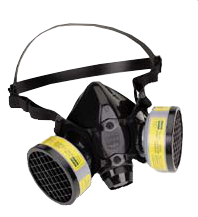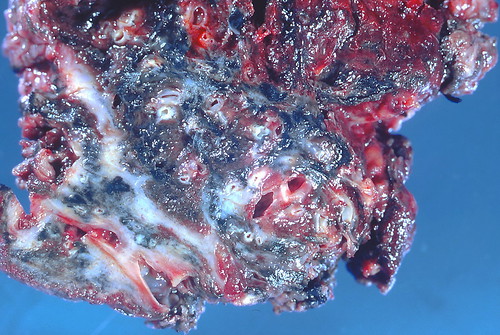Contents
Objectives
Upon completing this lesson students should be able to:
- Differentiate between the types of dust and their effects.
- Give examples of dust control.
- Identify toxic materials.
- Explain housekeeping.
- Explain spillage.
Reading & Lecture
Types of airborne particles and their effects on health
Respirable and non-respirable dust
- Non-respirable dust is less dangerous; larger particles are filtered out by the nose and throat
- Respirable dust is more dangerous; particles are invisible to the eye
Nuisance respirable dust
- Little effect on lungs
- Any reaction is potentially reversible
Respirable Dust:
- Fibrogenic dusts (harmful to respiratory system): silica (quartz), silicates (asbestos, mica), tin ore, coal, some iron ore
- Toxic dusts (poisonous): arsenic, lead, mercury, antimony, manganese, tungsten
- Explosive dusts (combustible when airborne): coal, metallic dusts (aluminum, zinc, tin …)
- Nuisance dust (little adverse effect): gypsum, kaolin, limestone
Fibrogenic respirable dust (e.g., asbestos, quartz)
- Small particles enter lower lungs. Accumulations of particles cause scar tissue to be formed. Scar tissue interferes with transfer of oxygen and carbon dioxide through the lungs.
- Silicosis is lung fibrosis caused by prolonged inhalation of silica dust.
- Pneumoconiosis is a generic term describing several types of respiratory ailments, one of which is coal workers’ pneumoconiosis.
- Major pneumoconiosis – lung disorder developed over a prolonged time causing disabling symptoms, is irreversible, and shortens life expectancy. Includes silica dioxide dusts, such as asbestos, quartz, and coal.
- Minor pneumoconiosis – dust causes little or no inflammation and no major fibrosis, but can cause mechanical irritation of the lungs. Includes micas, clays, feldspars, and anthracite.
- Benign pneumoconiosis – similar to minor pneumoconiosis. Includes calcium from limestone, marble, or-cement; graphite; titanium dioxide; stannic dioxide; ferric oxide; and barium sulfate or oxide.
Radon and Thoron daughters: are found in uranium and thorium ores. Daughters attach to dust particles and are inhaled into the lungs.
- Excessive exposure to radon and thoron daughters can cause lung cancer.
- Exposure measured in a unit known as the Working Level Month (WLM). Relevant formulas are:
Exposure = radiation level x time
Given that: radiation level is the working level, time is in months,
Then: exposure is working level months,
Or: Working Level Months = Working Level X Months- Formulas indicate miners should not spend prolonged time in excessively contaminated areas. Low levels of radiation are safe work areas.
- The law states that no miner can be exposed to more than 4 WLM in any one year.
- Smoking increases the risk of radiation causing lung cancer by a factor of ten.
Gamma and X-ray exposures
- Not considered dangerous in most uranium mines.
- Use film badges to measure exposure around high grade uranium ore.
Dust Control
Prevention:
- avoidance by modifying operations
- reduction of dusts with proper maintenance

Removal:
- cleanup of workings
- respirators that filter dusts
Suppression:
- water spray
- foam spray
- rock dusting to suppress combustible dust
Dilution:
- main ventilation system
- auxiliary ventilation system
The Most Common Dust Control Methods
Method of measurement for airborne particles
- Respirators that filter dusts
- Ventilation dilutes the concentration of dusts
- Water sprays suppress dusts
Method of measurement for airborne particles
- Respirable dusts
- Gravimetric sampling
- Time schedule for sampling
- Radon thoron daughters
- Air sampling
- Counting equipment
- Time schedule for sampling
- Gamma radiation
- Scintillation counts
- Time schedule for sampling
Threshold limit values
- Part 57.5-1b states that miners shall not be exposed to asbestos dust exceeding 10 fibers longer than 5 micrometers per milliliter of air
- Part 57.5-16 states that silica sand shall not be used as an abrasive substance in abrasive blasting cleaning operation.
- Part 57.5-38 and 39 state that the maximum exposure to radon daughters in any calendar year is 4 WLM, and 1.0 WL in active workings.
- Part 57.5-47c states that annual individual gamma radiation expo-sure shall not exceed 5 rems.
Hazards from Toxic Materials
- Types of toxic, caustic or noxious substances used in the mine.
- Procedures for handling toxic, caustic or noxious substances.
Health Provisions Contained in the Federal Mine Safety and Health Act of 1977 (CFR 30 Part 55 or 56):
- Regulations prescribe health and safety standards for the purpose of protecting life, promoting health and safety, and preventing accidents.
- Violations of these regulations may be cited by MSHA inspectors.
Housekeeping
Importance of Clean-up and Good Housekeeping
- Reduces the number of unsafe conditions which contribute to accidents. Oily rags, empty or uncovered grease and oil containers, tangled hoses, and discarded trash are examples of such hazards.
- A messy workplace slows down work. If tools are laying about unorganized, more time is required to find them.
- Cleaning-up during work is a good fire prevention technique. Areas around fuel and explosive supplies should be kept free of any flammable materials and trash.
Applicable Federal Regulation
- Maintenance of clean work places.
- The law states that workplaces, passageways, storerooms, and service rooms must be kept clean and orderly, and water drainage must be provided where practicable (Part 57.20-3)
- The law states that any health and safety hazard that is not immediately obvious must be labeled with a warning sign. This sign must “be readily visibly, legible, display the nature of the hazard, and any protective action required” (Part 57.20-11).
- Disposal of toxic materials.
- The law states that flammable and combustible wastes should not accumulate and become a fire hazard. (Part 57.4-50).
- The law states that potentially dangerous gases should be tested, and control measures taken as appropriate. (Part 57.20-9).
- The law states that toxic materials should be clearly labeled and safe handling procedures identified. (Part 57.30-12).
Housekeeping Procedures
- Organize your work ahead of time so you have all the equipment you need where you need it. Make cleaning-up part of your work.
- Clean up spills whenever and wherever they occur.
- After you are finished with equipment and no longer plan on using it for awhile, put it away such as in a supply room or other designated area. Park vehicles properly. Keep oily rags in closed containers and remove them from the mine daily.
- When handling tools, supplies, or equipment, use caution in how you handle them. Avoid hurting yourself, others, or the equipment itself. If a piece of equipment or a tool is broken, get it fixed or serviced rather than leaving it and letting another miner discover its condition when it may be for an emergency. The next time the tool could be needed in an emergency you could be the victim.
Benefits of Good Housekeeping
- Eliminates accident and fire hazards
- Maintains safe, healthy work conditions
- Saves time, money, materials, space and effort
- Improves productivity and quality
- Boosts morale
- Reflects a well-run organization
Good Housekeeping Habits
- Make time for housekeeping
- Evaluate your workspace
- Remove hazards before starting work
- Turn equipment off after using it
- Clean up as you go
- Never ignore a safety hazard
Spillage Hazards
- Rock spillage is found to varying degrees at a number of locations.
- Draw points
- Ore passes
- Grizzly or crusher
- Haulageways
- At transfer points from ore pass or muck car to haulage truck or ore car.
- Along belt lines and their transfer points.
- Hazards associated with rock spillage.
- Rock spillage poses safety hazards to miners and equipment. Miners can trip over rocks which is a leading cause of accidents and equipment has less room to operate and maneuver when crowded by spillage. Uneven floors caused by spillage is a major contributing cause of haulage accidents.
- Substantial rock spillage increases resistance to ventilation. Spillage cuts down the volume of air passing by.
- Rock spillage should be cleaned-up wherever it poses a health and safety hazard. Depending on the size of the spillage, either shovels or loaders should be used in clean-up.
